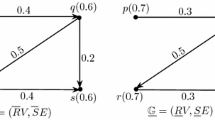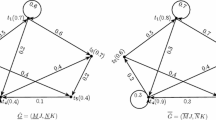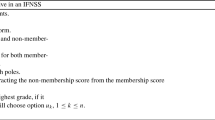Abstract
Intuitionistic fuzzy sets and rough sets are two different mathematical models to deal the problem of how to understand and manipulate imperfect knowledge. An intuitionistic fuzzy rough framework is made by combining these two models, which is a more flexible and expressive for modeling and processing incomplete information in information systems. In this research study, we introduce intuitionistic fuzzy rough graphs, and describe certain types of intuitionistic fuzzy rough graphs with several examples. We present applications of intuitionistic fuzzy rough graphs in decision-making problems. We develop efficient algorithms to solve decision-making problems and compute time complexity of each algorithm.



















Similar content being viewed by others
References
Zadeh LA (1965) Fuzzy sets. Inf Control 8(3):338–353
Bhutani KR (1989) On automorphism of fuzzy graphs. Pattern Recognit Lett 9(3):159–162
Atanassov KT (1986) Intuitionististic fuzzy sets. Fuzzy Sets Syst 20(1):87–96
Atanassov KT (1999) Intuitionistic fuzzy sets: theory and applications. Springer Physica-Verlag, Berlin
Atanassov KT, Pasi G, Yager R, Atanassova V (2003) Intuitionistic fuzzy graph interpretations of multi-person multi-criteria decision making. Proceedings of the 3rd Conference of the European Society for Fuzzy Logic and Technology, Zittau, Germany, September 10–12, pp 115–119
Atanassov KT, Pasi G, Yager R (2007) Intuitionistic fuzzy interpretations of multi-criteria multi-person and multi-measurement tool decision making. Int J Syst Sci 36(14):859–868
Pawlak Z (1991) Rough sets-theoretical aspects to reasoning about data. Kluwer Academic Publisher, Boston
Pawalak Z (1982) Rough sets. Int J Comput Inf Sci 11(5):341–356
Liu GL (2010) Rough set theory based on two universal sets and its applications. Knowl Based Syst 23(2):110–115
Griffin G, Chen Z (1998) Rough set extension of Tcl for data mining. Knowl Based Syst 11(3–4):249–253
Pei DW, Xu ZB (2007) Transformation of rough set models. Knowl Based Syst 20(8):745–751
Dai JH, Hu H, Wu WZ, Qian YH, Huang DB (2017) Maximal discernibility pairs based approach to attribute reduction in fuzzy rough sets. IEEE Transactions on Fuzzy Systems. https://doi.org/10.1109/TFUZZ.2017.2768044
Dai JH, Wei BJ, Zhang XH, Zhang QH (2017) Uncertainty measurement for incomplete interval-valued information systems based on a-weak similarity. Knowl Based Syst 136:159–171
Li J, Kumar Cherukuri Aswani, Mei Changlin, Wang Xizhao (2017) Comparison of reduction in formal decision contexts. Int J Approx Reason 80:100–122
Li J, Mei C, Lv Y (2013) Incomplete decision contexts: approximate concept construction, rule acquisition and knowledge reduction. Int J Approx Reason 54(1):149–165
Wang C, Shao M, He Q, Qian Y, Qi Y (2016) Feature subset selection based on fuzzy neighborhood rough sets. Knowl Based Syst 111(1):173–179
Wang C, Hu Q, Wang X, Chen D, Qian Y Feature selection based on neighborhood discrimination index. IEEE Transactions on Neural Networks and Learning Systems. https://doi.org/10.1109/TNNLS.2017.2710422
Wang C, He Q, Shao M, Hu Q Feature selection based on maximal neighborhood discernibility. International journal of machine learning and cybernetics. https://doi.org/10.1007/s13042-017-0712-6
Wang C, He Q, Shao M, Xua Y, Hu Q (2017) A unified information measure for general binary relations. Knowl Based Syst 135(1):18–28
Zhang XH (2017) Fuzzy anti-grouped filters and fuzzy normal filters in pseudo-BCI algebras. J Intell Fuzzy Syst 33:1767–1774
Zhang XH, Park C, Wu SP (2018) Soft set theoretical approach to pseudo-BCI algebras. J Intell Fuzzy Syst 34:559–568
Dubios D, Prade H (1990) Rough fuzzy and fuzzy rough sets. Int J Gen Syst 17(2–3):191–209
Chakrabarty K, Biswas R, Nanda S (2000) Fuzziness in rough sets. Fuzzy Sets Syst 110(2):247–251
Mi JS, Zhang WX (2002) Composition of general fuzzy approximation spaces. Springer, Berlin, pp 497–501
Cornelis C, De Cock M, Kerre EE (2003) Intuitionistic fuzzy rough sets: at the crossroads of imperfect knowledge. Expert Syst 20(5):260–271
Xu W, Liu Y, Sun W Intuitionistic fuzzy rough sets model based on \((\Theta , \Phi )\)-operators. 2012 9th International Conference on Fuzzy Systems and Knowledge Discovery (FSKD 2012): 234–238
Zhou L, Wu WZ (2008) On generalerized intuitionistic fuzzy rough approximation operators. Inf Sci 178(11):2448–2465
Huang B, Guo C, Zhuang YL, Li H, Zhou X (2014) Intuitionistic fuzzy multigranulation rough sets. Inf Sci 277:299–320
Wu WZ Intuitionistic fuzzy rough sets determined by intuitionistic fuzzy implicators. 2010 IEEE International Conference on Granular Computing, 536–540
Guo ZL, Yang HL, Wang J (2015) Rough set over dual-universes in intuitionistic fuzzy approximation space and its application. J Intell Fuzzy Syst 28(1):169–178
Yang HL, Li SG, Guo ZL, Ma CH (2012) Transformation of bipolar fuzzy rough set models. Knowl Based Syst 27:60–68
Yang HL, Li SG, Wang S, Wang J (2012) Bipolar fuzzy rough set model on two different universes and its application. Knowl Based Syst 35:94–101
Zhu K, Zhan J (2016) Fuzzy parameterized fuzzy soft sets and decision making. Int J Mach Learn Cybern 7(6):1207–1212
Zhan J, Liu Q, Herawan T (2017) A novel soft rough set: soft rough hemirings and its multicriteria group decision making. Appl Soft Comput 54:393–402
Shahzamanian MH, Shirmohammadi M, Davvaz B (2010) Roughness in Cayley graphs. Inf Sci 180:3362–3372
Kauffman A (1973) Introduction a la Theorie des Sous-emsembles Flous. Masson et Cie 12(4):213–227
Rosenfeld A (1975) Fuzzy graphs. In: Zadeh LA, Fu KS, Shimura M (eds) Fuzzy sets and their applications. Academic Press, New York
Bhattacharya P (1987) Some remarks on fuzzy graphs. Pattern Recognit Lett 6(5):297–302
Mordeson JN, Peng CS (1994) Operations on fuzzy graphs. Inf Sci 79(3–4):159–170
Mordeson JN, Nair PS (2000) Fuzzy graphs and fuzzy hypergraphs. Springer Physica-Verlag, Heidelberg Gmbl
Sunitha MS, Vijayakumar A (2002) Complement of a fuzzy graph. Indian J Pure Appl Math 33(9):1451–1464
Mathew S, Sunitha M (2009) Types of arcs in a fuzzy graph. Inf Sci 179(11):1760–1768
Mathew S, Sunitha M (2013) Strongest strong cycles and fuzzy graphs. IEEE Trans Fuzzy Syst 21:1096–1104
Pramanik T, Samanta S, Pal M (2016) Interval-valued fuzzy planar graphs. Int J Mach Learn Cybern 7:653664. https://doi.org/10.1007/s13042-014-0284-7
NagoorGani A, Akram M, Vijayalakshmi P (2016) Certain types of fuzzy sets in a fuzzy graph. Int J Mach Learn Cybern 7:573579. https://doi.org/10.1007/s13042-014-0267-8
Myithili KK, Parvathi R, Akram M (2016) Certain types of intuitionistic fuzzy directed hypergraphs. Int J Mach Learn Cybern 7:287295. https://doi.org/10.1007/s13042-014-0253-1
Borzooei RA, Rashmanlou H (2017) New concepts of vague graphs. Int J Mach Learn Cybern 8:10811092. https://doi.org/10.1007/s13042-015-0475-x
Parvathi R, Karunambigai MG, Atanassov KT (2009) Operations on intuitionistic fuzzy graphs. IEEE International Conference on Fuzzy Systems, Jeju Island, Korea 20–24:1396–1401
Akram M, Ashraf A, Sarwar M (2014) Novel applications of intuitionistic fuzzy digraphs in decision support systems. The Scientific World Journal 2014. Article ID 904606
Akram M, Saira N (2016) Fuzzy soft graphs with applications. J Intell Fuzzy Syst 30(6):3619–3632
Akram M, Shahzadi S (2016) Novel intuitionistic fuzzy soft multiple-attribute decision-making methods. Neural Computing and Applications. https://doi.org/10.1007/s00521-016-2543-x
Akram M, Alshehri N, Davvaz B, Ashraf A (2016) Bipolar fuzzy digraphs in decision support systems. J. Multiple-Valued Logic Soft Comput 27:531–551
Molina-Solana M, Birch D, Guo Y (2017) Improving data exploration in graphs with fuzzy logic and large-scale visualisation. Appl Soft Comput 53:227–235
Akram M, Zafar F (2018) Journal of Applied Mathematics and Computing. https://doi.org/10.1007/s12190-018-1171-2
Zafar F, Akram M (2018) A novel decision-making method based on rough fuzzy information. Int J Fuzzy Syst 20(3):1000–1014. https://doi.org/10.1007/s40815-017-0368-0
Malik HM, Akram M (2018) A new approach based on intuitionistic fuzzy rough graphs for decision-making. J Intell Fuzzy Syst 34(4):2325–2342. https://doi.org/10.3233/JIFS-171395
Akram M, Malik HM, Shahzadi S, Smarandache F (2018) Neutrosophic soft rough graphs with application. Axioms 7(1): https://doi.org/10.3390/axioms7010014
Acknowledgements
The authors are very thankful to the Editor and referees for their valuable comments and suggestions for improving the paper. This research is partially supported by a grant of National Natural Science Foundation of China (11461025).
Author information
Authors and Affiliations
Corresponding author
Ethics declarations
Conflicts of interest
The authors declare that they have no conflict of interest.
Additional information
Publisher’s Note
Springer Nature remains neutral with regard to jurisdictional claims in published maps and institutional affiliations.
Rights and permissions
About this article
Cite this article
Zhan, J., Masood Malik, H. & Akram, M. Novel decision-making algorithms based on intuitionistic fuzzy rough environment. Int. J. Mach. Learn. & Cyber. 10, 1459–1485 (2019). https://doi.org/10.1007/s13042-018-0827-4
Received:
Accepted:
Published:
Issue Date:
DOI: https://doi.org/10.1007/s13042-018-0827-4




